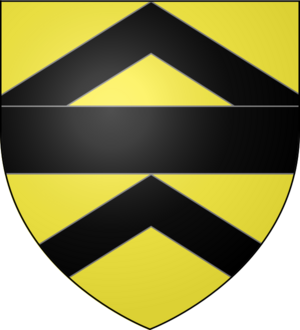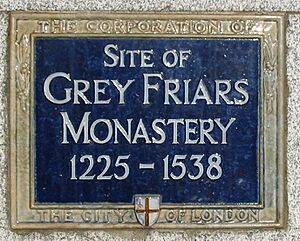Robert Lisle, 1st Baron Lisle of Rougemont facts for kids
Quick facts for kids
Robert de Lisle, 1st Baron Lisle
|
|
|---|---|

Arms of Robert de Lisle, 1st Baron Lisle. Or, a fess between two chevrons sable.
|
|
| Born | 20 January 1288 Campton, Bedfordshire |
| Died | 4 January 1344 (aged 55) |
| Buried | Greyfriars, London |
| Spouse(s) | Margaret de Beauchamp |
| Issue |
|
| Father | Warin de Lisle |
| Mother | Alice de Montfort |
Robert de Lisle, 1st Baron Lisle (born January 20, 1288 – died January 4, 1344) was an important English nobleman. He served in the army in Scotland and fought in a battle called the Battle of Boroughbridge. Later in his life, after his wife passed away, he became a member of the Franciscan religious group. He was also the owner of a special old book called the Lisle Psalter.
Contents
Early Life and Family
Robert de Lisle was born on January 20, 1288, in a place called Campton, Bedfordshire. His father was Sir Warin de Lisle, and his mother was Alice de Montfort. Alice's father, Sir Peter de Montfort, was from Beaudesert Castle in Warwickshire.
Robert was still a child when his father died in 1296. When he turned 21, in 1310, he officially took control of his father's lands. A few days later, King Edward II gave him even more lands, including a manor in Harewood.
Military Service and Public Life
Robert de Lisle was often called upon to serve the King. He was asked to join the army, attend important meetings, and be part of Parliament. These calls meant he became known as Lord Lisle.
In 1312, he was given permission to hold a yearly fair in Shefford, Bedfordshire. This town was close to his home in Campton. The next year, in 1313, he traveled to Paris with King Edward II and Queen Isabella of France.
In 1314, Robert was called to fight in Scotland. This was during the time of the Battle of Bannockburn. The following year, he was told to stay in the North for a winter army campaign. He continued to serve the King in 1316 and 1317.
In 1322, he fought alongside the King at the Battle of Boroughbridge. This was an important battle in English history. Later, in 1323, he was given the responsibility of looking after a young man named Edmund Peverel.
Robert was also asked to join an expedition to Gascony in 1324, but this trip did not happen. In 1328, he went on a pilgrimage, which is a special religious journey, to Santiago de Compostela. By 1332, he was appointed to help keep the peace in Cambridgeshire.

By 1336, King Edward III understood that Robert was getting older and weaker. The King decided that Robert would not have to fight in wars or attend Parliament anymore. However, Robert still served on peace commissions in Cambridgeshire until 1341. He was also called to a council meeting in 1342.
Later Life and Legacy
Robert's wife, Margaret, passed away in the summer of 1339. After her death, he decided to join the Franciscan religious order. Because he joined this order, his lands were taken over by the King in 1342. It is believed that he became a priest.
Robert de Lisle died on January 4, 1344. He was buried in the Franciscan church in London.
Robert owned a very special book called the Lisle Psalter. This book was beautifully decorated by hand. He gave it to his daughter Audrey, who was a nun. Audrey said that after she died, the book should go to her sister Aubrey, who was also a nun. After Aubrey's death, the book was meant to go to Chicksands Priory. This priory was built on land given by Robert's family near their home in Campton.
Marriage and Children
Around July 9, 1301, Robert de Lisle married Margaret de Beauchamp. She was the daughter of Walter de Beauchamp from Alcester, Warwickshire. Together, Robert and Margaret had three sons and four daughters:
- John de Lisle, 2nd Baron Lisle: He married Maud de Grey.
- Robert de Lisle
- Thomas de Lisle
- Alice de Lisle: She married Sir Thomas de Seymour. She later married Robert Peverel.
- Elizabeth de Lisle: She married Sir Edmund de Peverel. They had a son named John and a daughter named Margaret.
- Audrey de Lisle: She became a nun.
- Aubrey de Lisle: She also became a nun.

